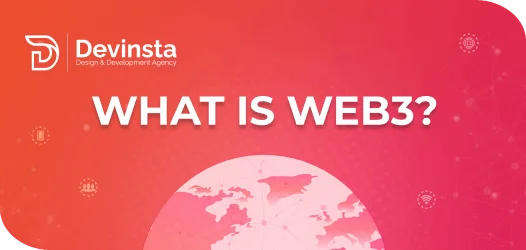What is web3 and why its going great - Devinsta

Web3 An emerging internet paradigm/revolution
The evolution of the internet has been happening globally over the past few years. Currently, one of the dominant paradigms is web2 however another emerging alternative has been sweeping the tech industry, known as web3. The rise of Web3 is not just another chapter in the evolution of the internet. It's a seismic shift toward a more decentralized and user-centric web. This blog will explore everything you need to know to understand Web3 and its comparison with Web2 in the forthcoming paragraphs.
Comparison of Web2 and Web3
Web2 also known as the “Social Web”, is a network consisting of various platforms including Facebook, Google, Amazon etc. These social media platforms provide numerous services and in exchange collect user data. Their services are mostly user friendly with huge user bases making them attractive for marketing and business advertisements. Web2 has been a source of various innovations in different areas like social media networking, google search, and e-commerce. However, collections of user data often leading to its exploitation has raised major security concerns. On the other hand, Web3 is going great refers to the internet’s third generation. Main goal of Web3 is to replace traditional internet platforms with various decentralized technologies. For instance, blockchain, ownership of digital assets and control of data by users. It promotes the concept of decentralized applications (DApps), finance (DeFi), and non-fungible tokens (NFTs) etc.
Importance of Web3 Startups
Recently, there have been a lot of startups in Web3 creating the foundation of the decentralized web. Blockchain technology is the core of web3 providing transparency, security, and decentralization. The startups in web3 are leveraging blockchain to create new possibilities. The decentralization of web3 startups enables users to have more control over their data, and digital assets. This has far-reaching implications, from digital ownership to in-game items in Decentralized Gaming in the Web3 ecosystem including Castle Age. Blockchain technology allows for unique in-game assets and transparent game mechanics, involving the use of NFTs to represent in-game items, characters, or assets as players could have true ownership of these digital assets. Some Web3 games incorporate DeFi elements, allowing players to earn cryptocurrencies or tokens within the game. These can be used or traded in broader DeFi ecosystems.Furthermore, Web3 startups are also developing privacy-focused solutions to protect user data as well. It is the opposite of data collection practices of traditional Web2 companies. They are pushing the boundaries of what's possible on the web. Decentralized finance (DeFi) platforms, applications (DApps), and autonomous organizations (DAOs) are just a few examples of Web3 innovations. Other than that, some of the Web3 Startups are mentioned as follows.
Chainlink
It opens the door to a wide range of decentralized applications by connecting smart contracts with real-world data.
Uniswap
It is a decentralized exchange (DEX) allowing users to swap various cryptocurrencies through automated smart contracts.
Aave
It allows users to lend their digital assets to others or borrow assets, all governed by smart contracts.
OpenSea
It is a marketplace for buying, selling, and trading NFTs and allowing users to monetize their digital content.
Filecoin
It aims to revolutionize cloud storage where users can rent their excess storage space and earn Filecoin tokens in return. The Web3 startup ecosystem is still in its beginning, but it holds immense promise. As blockchain technology matures, scalability and usability improve, and regulatory frameworks evolve, we can expect even more innovation and adoption. Web3 startups are not just creating new technologies; they are reintroducing the very concept of the internet by building a more user-centric web. These startups are shaping the future of the internet, and their impact is only beginning to be felt.
Web3 Design Agency
Another considerable merit associated with this development is web3 design agency. It focuses on designing and developing user interfaces and experiences for decentralized projects. These agencies are different from typical web design agencies. They specialize in integrating blockchain technology and smart contracts into the user interface, allowing users to interact seamlessly. They prioritize user-centric design principles, ensuring that DApps and blockchain-based platforms are user-friendly, and accessible to a wide audience. They also assist in token design and branding for blockchain projects, creating interfaces that emphasize transparency and security. Given the multi-chain nature of Web3, these agencies design interfaces that work across different blockchain networks, ensuring compatibility and usability. In short, a Web3 design agency is a creative partner for blockchain and Web3 projects. It contributes to making decentralized applications and blockchain-based platforms more accessible and appealing to a broader audience.
Web3 Live
Web3 live is actively running on blockchain networks and decentralized applications and can be accessed by users in real-time. It relates to events, conferences, or webinars focused on Web3 and blockchain technologies. These events often bring together experts, developers, and enthusiasts to discuss the latest developments and trends in the Web3 space. One of them is Nicole Junkermann, a well-known entrepreneur and investor with interests in various industries, including technology and healthcare. She has been associated with a range of ventures and investments. Web3 is the next generation of the internet aiming to be more decentralized, user-centric, and powered by technologies like blockchain. Several entrepreneurs, investors, and technologists have shown interest in this emerging space; however, their roles and contributions vary widely.
Conclusion
In conclusion, it is an undeniable fact that Web3 is an exciting evolution of the internet. Both Web2 and Web3 have their merits, as Web2 provides convenience and familiarity, making it ideal for everyday internet activities. However, it raises significant concerns about data privacy and control. Whereas, Web3 is going great offers a promising vision of a more user-centric and decentralized internet, with enhanced privacy and ownership rights. Even though it is still in its experimental phase, facing challenges related to scalability, usability, and regulation. In my opinion, the ideal scenario would be a harmonious integration of the best aspects of both Web2 and Web3. We should strive for user control over data, privacy, and digital assets while maintaining the convenience and innovation of Web2. Achieving this balance will be the key to creating a better internet for the future.


